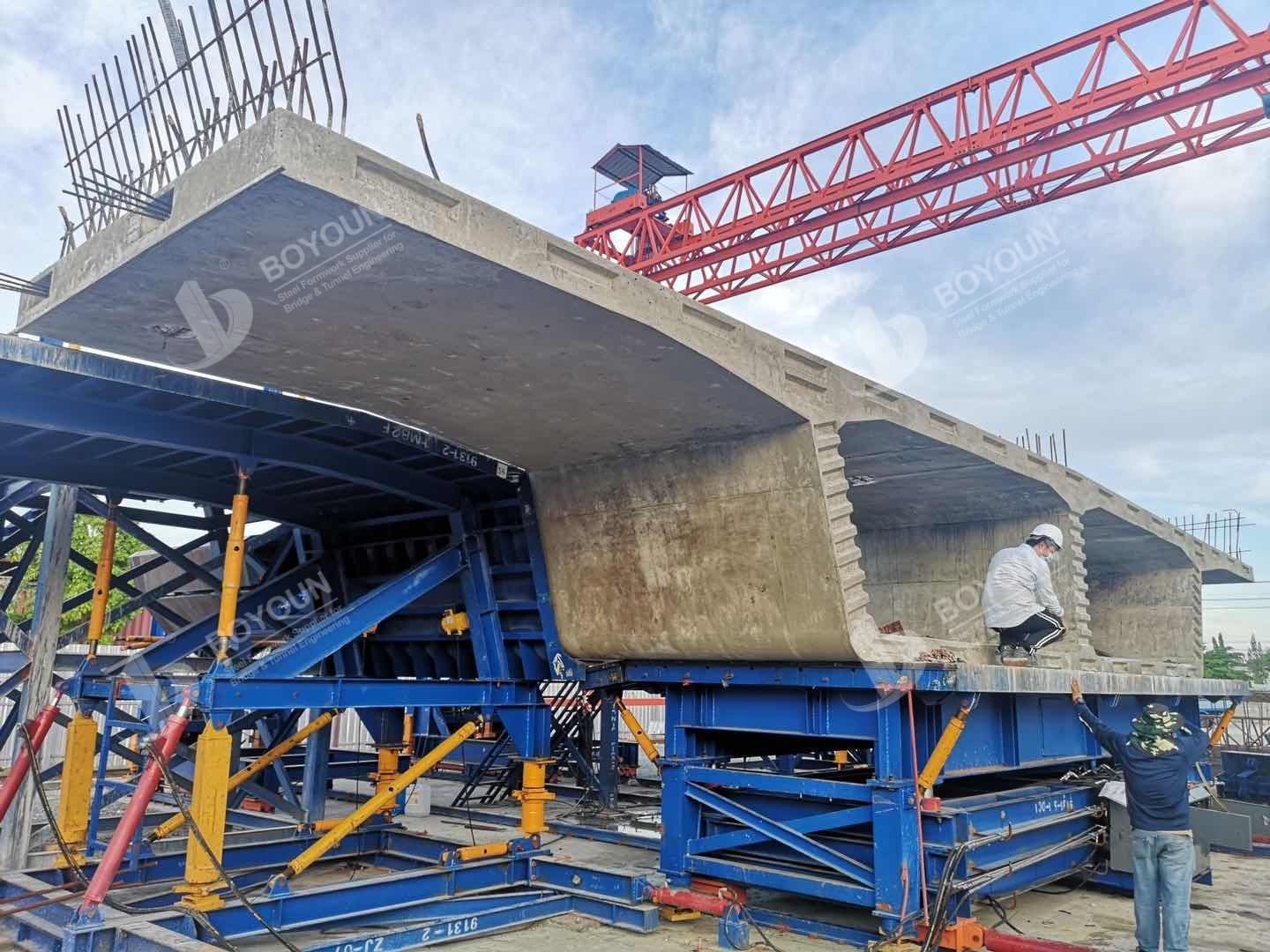The long-line method and the short-line method are the two main ways of segment prefabrication construction.
The long-line prefabrication and assembly refers to assembling and prefabricating segment by segment on a long platform base according to the designed alignment of the finished beam, so that two segments form a matching surface.
The long-line method has the advantages of being easy to layout, operation and control, and capable of realizing synchronous coordination of multiple parts, thus accelerating the project construction. Moreover, the beam segments do not need to be immediately transferred to the warehouse after demoulding, the utilization rate of the bottom mold is low and errors will not accumulate. However, its disadvantages include occupying a large space; the pouring and curing devices are all mobile types; the platform base must be built on a solid foundation and cannot be reused on other items, and curved bridges also require a certain degree of curvature, etc.
The short-line method is to use a fixed end mold on one side and the already poured adjacent segment as the matching end mold (end molds can also be set on both sides) to complete the control and realize prefabrication. The beam segments move from the pouring position to the corresponding position, cooperate with newly poured beam segments, and then are transported to the storage site. The short-line prefabrication method has the characteristics of fast construction and less land occupation, and the formwork is highly efficient in utilization. It is suitable for flat curve and vertical curve bridge shapes.

1.2 Superstructure Construction
When adopting prefabrication and assembly technology, the assembly process can be reasonably adjusted in combination with the specific conditions of the project site, as well as factors such as equipment and cost. Presently, the following common assembly methods are available:
① Crane hoisting. The crane is composed of gantry cranes, jib cranes, crawler cranes, etc. Regardless of the type of crane utilized, it must meet the following conditions: Firstly, the hoisting capacity of the crane should meet the hoisting requirements of the largest component; secondly, the crane should be able to move freely horizontally and be able to be positioned under certain assembly conditions; at a certain installation location, the crane can freely perform vertical hoisting and longitudinal movement, and can freely control the position of the hoisted object.
② Hoisting equipment. Construction site vehicles are also hoisting equipment. This kind of machinery is usually fixed on the last segment that has been installed and gradually moves forward during the assembly process. Although this assembly method has a large lifting capacity, since it is located at the last segment, it will have a certain impact on each segment during hoisting.
③ Truss hoisting. This method has good hoisting performance and is particularly suitable for the assembly and hoisting of beams in cantilever projects. When hoisting, both the front and rear ends of the truss are on the prefabricated segments. After each area of work is completed, it can be transferred to the next area.
④ Progressive hoisting. The progressive hoisting method is similar to the whole-span assembly, that is, from the upper span segment to the next span of the continuous beam step by step, and the segment initial mass is supported by steel strands. After about one-third of the hoisting work is completed, internal prestressed tendons can be used to tension the beam, and the work is carried out in sequence until all segments of the whole span are assembled.
1.3 Installation of Prefabricated Columns and Prefabricated Pier Cap
Before the installation of prefabricated columns, the concrete strength of the base should meet the design requirements.
① Before assembly, the length, width and height of the cup mouth must be checked to confirm whether they are qualified. The contact surface between the cup mouth and the prefabricated part should be roughened, then it should be derusted and its positioning should be checked. Ensure that it meets the requirements before assembly.
② After the prefabricated column is assembled, hardwood wedges or steel wedge bolts should be used for fixing, and diagonal braces should be equipped to ensure the stability of the column. The lifting hook can be removed when safety is guaranteed.
③ After the construction is completed, the cup mouth concrete should be grouted immediately. After the cement is solidified, the hard wedges should be removed, and then the secondary concrete grouting should be carried out. When the concrete in the cup mouth reaches 75% of the strength, it can be disassembled. The construction of pre-stressed concrete bridge deck beams and slabs must meet the following requirements:
1) Before assembling the prefabricated cap beam, the cement surface at the connection should be roughened, and the surface of the embedded parts should be derusted.
2) When constructing the prefabricated cap beam on the pier column, it must be reinforced and supported to ensure its stability.
3) After the cap beam is in place, its axis and the dimensions of each part must be inspected first to determine whether it meets the requirements before installation, and then the joint concrete should be grouted. The temporary fastening equipment can only be removed when the reinforced concrete at the connection reaches the specified strength.
To Wrap Up
Compared with ordinary urban road construction, the prefabricated concrete assembly construction process has the advantages of higher construction quality, shorter construction period, less noise generation, lower environmental pollution to the surrounding area, and obvious social benefits, and has a high degree of civilized construction. Therefore, each construction enterprise should strengthen the research on the prefabrication and assembly process.

International Department: Room 2211-2212, Tower C of Wanda Plaza, Tongzhou District, Beijing 101118, China.
+86-13021287080
info@boyoun.cn